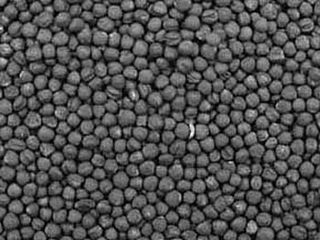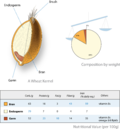Grain
Edible dry seed From Wikipedia, the free encyclopedia
A grain is a small, hard, dry fruit (caryopsis) – with or without an attached hull layer – harvested for human or animal consumption.[1] A grain crop is a grain-producing plant. The two main types of commercial grain crops are cereals and legumes.
This article needs additional citations for verification. (June 2022) |

After being harvested, dry grains are more durable than other staple foods, such as starchy fruits (plantains, breadfruit, etc.) and tubers (sweet potatoes, cassava, and more). This durability has made grains well suited to industrial agriculture, since they can be mechanically harvested, transported by rail or ship, stored for long periods in silos, and milled for flour or pressed for oil. Thus, the grain market is a major global commodity market that includes crops such as maize, rice, soybeans, wheat and other grains.
Cereal and non-cereal grains
In the grass family, a grain (narrowly defined) is a caryopsis,[2] a fruit with its wall fused on to the single seed inside, belonging to a cereal such as wheat, maize, or rice. More broadly, in agronomy and commerce, seeds or fruits from other plant families are called grains if they resemble cereal caryopses. For example, amaranth is sold as "grain amaranth", and amaranth products may be described as "whole grains". The pre-Hispanic civilizations of the Andes had grain-based food systems, but at higher elevations none of the grains belonged the cereal family. All three grains native to the Andes (kaniwa, kiwicha, and quinoa) are broad-leaved plants rather than grasses.[3]
Cereal grains
Many different species of cereal are cultivated for their grains.[4]
- A wheat kernel, its composition and the nutritional values of its parts.
- Rice grains by the IRRI
Warm-season cereals
Cool-season cereals
Pseudocereal grains

Starchy grains from broadleaf (dicot) plant families are cultivated as nutritious alternatives to cereals. The three major pseudocereal grains are:[5]
- amaranth (Amaranth family) also called kiwicha
- buckwheat (Smartweed family)
- quinoa (Amaranth family, formerly classified as Goosefoot family)
Pulses or grain legumes

Pulses or grain legumes,[6] members of the pea family, have a higher protein content than most other plant foods, at around 20%, while soybeans have as much as 35%. As is the case with all other whole plant foods, pulses also contain carbohydrates and fat. Common pulses include:
- chickpeas
- common beans
- common peas (garden peas)
- fava beans
- lentils
- lima beans
- lupins
- mung beans
- peanuts
- pigeon peas
- runner beans
- soybeans
Oilseed grains
Oilseed grains[7] are grown primarily for the extraction of their edible oil. Vegetable oils provide dietary energy and some essential fatty acids.[8] They are also used as fuel and lubricants.[9]
Mustard family

- black mustard
- India mustard
- rapeseed (including canola)
Aster family

Other families
Historical importance
Because grains are small, hard and dry, they can be stored, measured, and transported more readily than can other kinds of food crops such as fresh fruits, roots and tubers.[10] The development of grain agriculture allowed excess food to be produced and stored easily which could have led to the creation of the first temporary settlements and the division of society into classes.[11]
This assumption that grain agriculture led to early settlements and social stratification has been challenged by James Scott in his book Against the Grain.[12] He argues that the transition from hunter-gatherer societies to settled agrarian communities was not a voluntary choice driven by the benefits of increased food production due to the long storage potential of grains, but rather that the shift towards settlements was a coerced transformation imposed by dominant members of a society seeking to expand control over labor and resources.
Trade
Summarize
Perspective
The grain trade refers to the local and international trade in cereals such as wheat, barley, maize, rice, and other food grains. Grain is an important trade item because it is easily stored and transported with limited spoilage, unlike other agricultural products. Healthy grain supply and trade is important to many societies, providing a caloric base for most food systems as well as important role in animal feed for animal agriculture.
The grain trade is as old as agricultural settlement, identified in many of the early cultures that adopted sedentary farming. Major societal changes have been directly connected to the grain trade, such as the fall of the Roman Empire. From the early modern period onward, grain trade has been an important part of colonial expansion and international power dynamics. The geopolitical dominance of countries like Australia, the United States, Canada and the Soviet Union during the 20th century was connected with their status as grain surplus countries.
More recently, international commodity markets have been an important part of the dynamics of food systems and grain pricing. Speculation, as well as other compounding production and supply factors leading up to the 2007–2008 financial crises, created rapid inflation of grain prices during the 2007–2008 world food price crisis. More recently, the dominance of Ukraine and Russia in grain markets such as wheat meant that the Russian invasion of Ukraine in 2022 caused increased fears of a global food crises in 2022. Changes to agriculture caused by climate change are expected to have cascading effects on global grain markets.[13][14][15][16]Occupational safety and health
Those who handle grain at grain facilities may encounter numerous occupational hazards and exposures. Risks include grain entrapment, where workers are submerged in the grain and unable to extricate themselves;[17] explosions caused by fine particles of grain dust,[18] and falls.
See also
References
External links
Wikiwand - on
Seamless Wikipedia browsing. On steroids.





